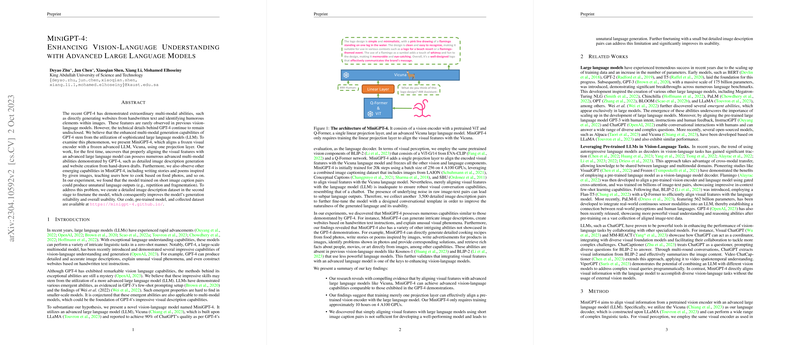Enhancing Vision-Language Understanding with MiniGPT-4
The paper "MiniGPT-4: Enhancing Vision-Language Understanding with Advanced LLMs" by Deyao Zhu et al. introduces a novel approach to vision-language integration that aims to replicate the multi-modal capabilities demonstrated by GPT-4. The authors propose MiniGPT-4, a model that aligns a frozen visual encoder with a frozen advanced LLM using a single projection layer. This alignment enables the model to exhibit a wide array of multi-modal abilities similar to those seen in GPT-4, such as detailed image description generation and website creation from hand-drawn drafts.
Methodology
The MiniGPT-4 architecture is designed to harness the capabilities of two existing components: the Vicuna LLM, built upon LLaMA, and the visual components from BLIP-2, which include a ViT-G/14 from EVA-CLIP and a Q-Former network. The innovative aspect of MiniGPT-4 lies in the employment of a single linear projection layer to bridge the visual encoder and the LLM. Both the visual and LLMs remain frozen during initial training, with only the projection layer being trained to achieve alignment.
The training procedure involves two distinct stages:
- Pretraining Stage: The model undergoes an initial training phase of 20,000 steps using a large combined dataset of image-text pairs, derived from sources like LAION, Conceptual Captions, and SBU.
- Finetuning Stage: To address issues of unnatural language output observed in the pretrained model, a second-stage of finetuning is implemented. A specifically curated dataset of ~3,500 detailed image description pairs is used to enhance the model's generation reliability and overall usability.
Experimental Results
The experiments conducted highlight MiniGPT-4's advanced capabilities in various vision-language tasks:
- Generating detailed image descriptions
- Creating websites from handwritten drafts
- Explaining humorous elements in memes
- Generating cooking recipes from food photos
- Writing stories and poems inspired by images
- Diagnosing plant diseases based on photos
The quantitative results, particularly in image captioning tasks, show that MiniGPT-4 outperforms previous models like BLIP-2, demonstrating a higher success rate in generating captions aligned with ground-truth visual objects and relationships.
In addition to these tasks, the model's performance is evaluated on traditional VQA datasets such as AOK-VQA and GQA, showing that MiniGPT-4, even with its minimal learnable parameters, exhibits reasonable performance and can benefit significantly from additional training and finetuning in these domains.
Analysis and Implications
The paper also provides an analysis of the second-stage finetuning's effectiveness. The results indicate a substantial improvement in the model's ability to generate natural and coherent language outputs. Furthermore, the experiments reveal that more complex model architectures or additional finetuning of the Q-Former don't necessarily yield better results, highlighting the efficiency of the single projection layer approach.
However, the authors acknowledge the limitations of MiniGPT-4, particularly in hallucination and spatial information understanding. The model sometimes generates descriptions including non-existent details or misinterprets spatial relationships in images. Addressing these issues could involve integrating reinforcement learning with AI feedback and training on datasets specifically designed for spatial understanding.
Future Directions
The implications of this research are significant for both practical applications and theoretical advancements in AI. MiniGPT-4's ability to generalize advanced vision-language tasks through limited, but high-quality, finetuning sets a precedent for future models. Further investigations might focus on refining the model's visual perception, reducing hallucination, and improving spatial understanding.
Future developments could leverage more extensive datasets, optimize training strategies, and explore the compositional generalization mechanisms that underpin advanced multi-modal capabilities. By delving deeper into these areas, researchers can continue to push the boundaries of what vision-LLMs can achieve, making them more robust and versatile for a wide range of applications.
In summary, MiniGPT-4 offers a promising approach to enhancing vision-language understanding using advanced LLMs, demonstrating that even minimal architectural adjustments can lead to substantial improvements in multi-modal AI capabilities. This work stands as a valuable contribution to the field, providing insights and methodologies that can propel further research and development.
